what is typically included in the range of data selected to create a chart
Lesson fifteen: Creating a Chart
/en/excelxp/applying-font-color-and-borders-to-cells/content/
Introduction
Past the finish of this lesson, you should be able to:
- Identify the parts of a chart
- Place different types of charts
- Create an embedded chart
- Create a nautical chart sail
Understanding the different chart types
Excel XP allows yous to create many different kinds of charts.
Surface area chart
An area chart emphasizes the trend of each value over fourth dimension. It besides shows the relationship of parts to a whole.
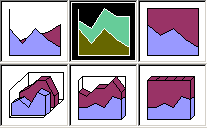
Column chart
A column chart uses vertical bars or columns to brandish values over different categories. It is ideal for showing variations in value over fourth dimension.
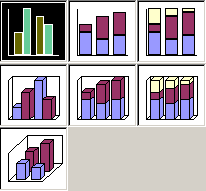
Bar chart
A bar chart is similar to a column chart except information technology uses horizontal rather than vertical bars. Similar to the cavalcade chart, the bar chart shows variations in value over time.
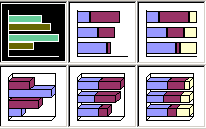
Line chart
A line chart shows trends and variations in data over time, displaying a series of points that are connected over fourth dimension.
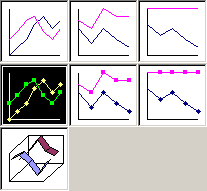
Pie chart
A pie chart displays the contribution of each value to the total. Pie charts are an constructive way to display information when you want to stand for different parts of the whole, or the percentages of a total.
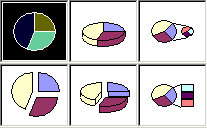
Other charts
Other charts that can be created in Excel XP include doughnut, stock XY (scatter), bubble, radar, and surface, as well every bit cone, cylinder, and pyramid charts.
Identifying the parts of a chart
Accept you e'er read something you didn't fully empathise, but when you saw a chart or graph the concept became articulate and understandable? Charts are a visual representation of data in a worksheet. Charts make it piece of cake to see comparisons, patterns, and trends in data.
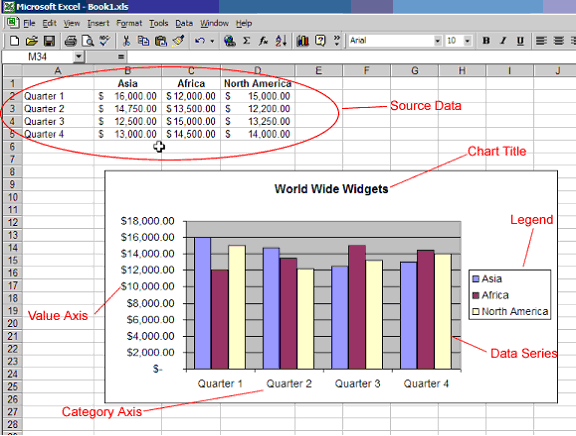
Source data
This is the range of cells that make up a nautical chart. The chart is updated automatically whenever the information in these cells changes.
Title
This is the title of the chart.
Legend
This is the nautical chart fundamental, which details what each color on the chart represents.
Centrality
This is the vertical and horizontal parts of a chart. The vertical axis is frequently referred to every bit the Y axis, while the horizontal axis is referred to as the X axis.
Data serial
This is the actual charted values, which commonly are rows or columns of the source data.
Value axis
This is the centrality that represents the values or units of the source information.
Category axis
This is the centrality identifying each data series.
Creating a chart using the Chart toolbar
Charts can be created in a number of ways in Excel XP. The quickest way to create and edit your charts is to utilise the Nautical chart toolbar.
To show the Chart toolbar:
Parts of the Chart toolbar:
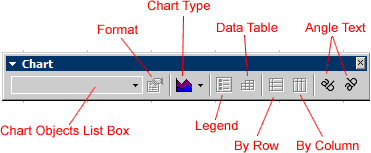
Chart objects listing box
This list box lets you select unlike parts of a chart for editing.
Format nautical chart area
This is used to format the part of the nautical chart that is currently selected.
Chart type
This is a drop-down menu that lets you select different types of charts. The chart type can be changed at any fourth dimension.
Fable
This is used to show or hide the chart legend.
Data tabular array
This is used to bear witness or hide the actual source data that was used to create the chart.
By row
This plots the information serial using the row labels (Y axis).
By column
This plots the information series using the column labels (X axis).
Angle text
This is used to rotate the angle of the X axis and Y axis labels.
Creating an embedded nautical chart
Charts tin can exist created in one of two ways in Excel XP: embedded charts and chart sheets. Excel creates an embedded chart by default. An embedded chart is placed on the same worksheet as the source data that was used to create it.
To embed a chart in a worksheet:
- Choose View
 Toolbars
Toolbars Chart on the carte bar.
Chart on the carte bar. - Select the range of cells you want to nautical chart. Your source data should include at least three categories or numbers.
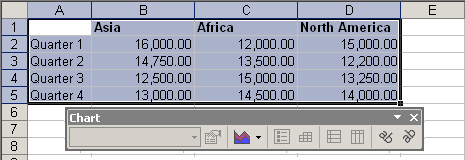
- Click the chart type drop-downward menu on the Chart toolbar and select the nautical chart you want to use.

- Open the chart options dialog box by clicking Chart
 Options to add a championship to your chart.
Options to add a championship to your chart.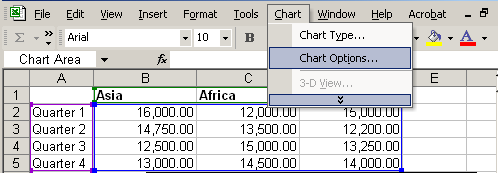
- Select the Titles tab, and blazon the championship of the nautical chart in the Nautical chart Title text box.
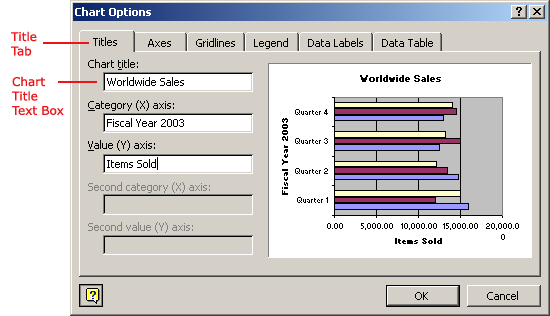
 Different charts piece of work best with different data. A pie nautical chart, for instance, can merely display i data series at a time.
Different charts piece of work best with different data. A pie nautical chart, for instance, can merely display i data series at a time.
 Excel XP includes a iv-step Chart Wizard you lot tin utilise to guide you through the steps for creating a chart. Highlight the cell range yous desire to chart, choose Insert
Excel XP includes a iv-step Chart Wizard you lot tin utilise to guide you through the steps for creating a chart. Highlight the cell range yous desire to chart, choose Insert Chart on the menu bar, and follow the instructions in the wizard.
Chart on the menu bar, and follow the instructions in the wizard.
Creating a nautical chart sheet
Sometimes you may desire to create a chart and place it on a separate canvass in the workbook. This is called a chart sheet. Chart sheets tin can make your charts stand out, particularly when yous're working with complicated spreadsheets.
To movement an embedded chart to a chart sheet:
- Create an embedded nautical chart.
- Select the nautical chart to be moved to a chart sheet.
- Choose Chart
 Location from the menu bar.
Location from the menu bar.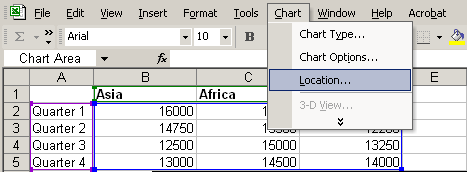
- In the Nautical chart Location dialog box, select As a new canvas.
(The Every bit object in radio push adds the nautical chart as an embedded object on the worksheet.)
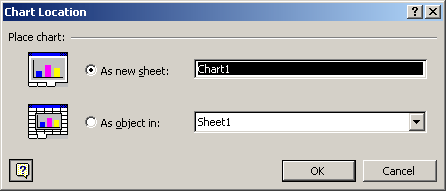
- Click OK. The chart is displayed on a separate chart sheet in the workbook.
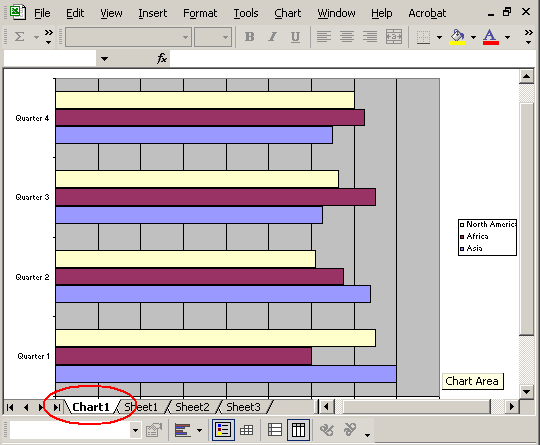
 You can also use the Chart Location dialog box to rename the chart sheet.
You can also use the Chart Location dialog box to rename the chart sheet.
Challenge!
- Type the following information on the worksheet:
In prison cell A2, type January
In cell A3, type Feb
In cell A4, blazon March
In cell B1, type Bill
In cell B2, blazon 3542
In cell B3, type 7184
In cell B4, type 6531
In jail cell C1, type Mary
In cell C2, type 2943
In jail cell C3, blazon 6542
In prison cell C4, type 7137
In cell D1, type Bob
In cell D2, type 3403
In cell D3, blazon 7314
In cell D4, type 6942 - Create an embedded line chart showing the numbers on the Y axis and the months on the Ten centrality.
- Change the embedded line chart to an area chart.
- Convert the embedded area chart to a chart canvas.
/en/excelxp/moving-resizing-and-deleting-charts/content/
Source: https://edu.gcfglobal.org/en/excelxp/creating-a-chart/1/
0 Response to "what is typically included in the range of data selected to create a chart"
Post a Comment